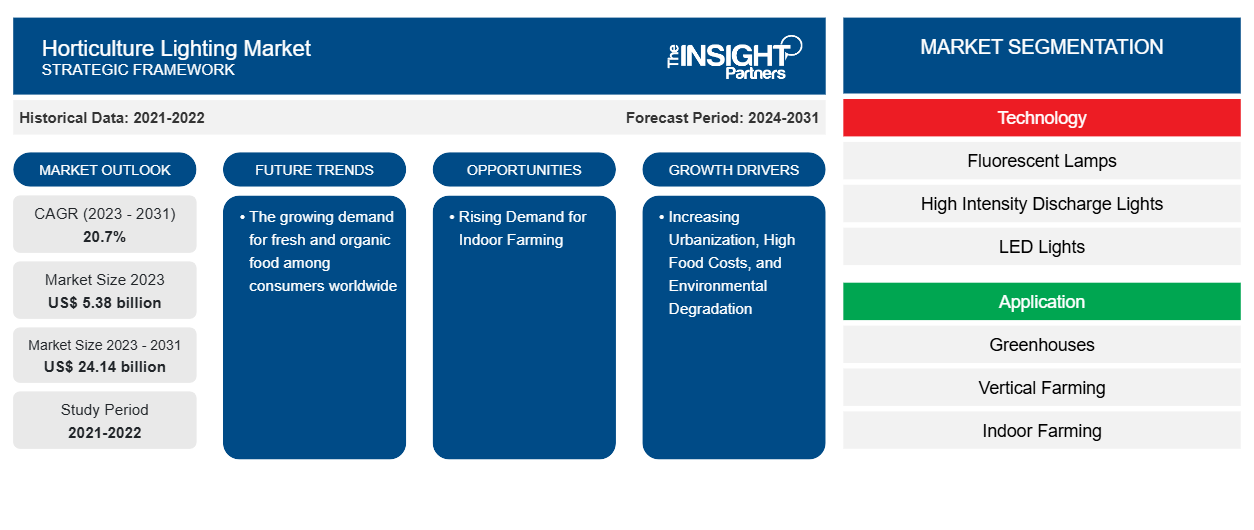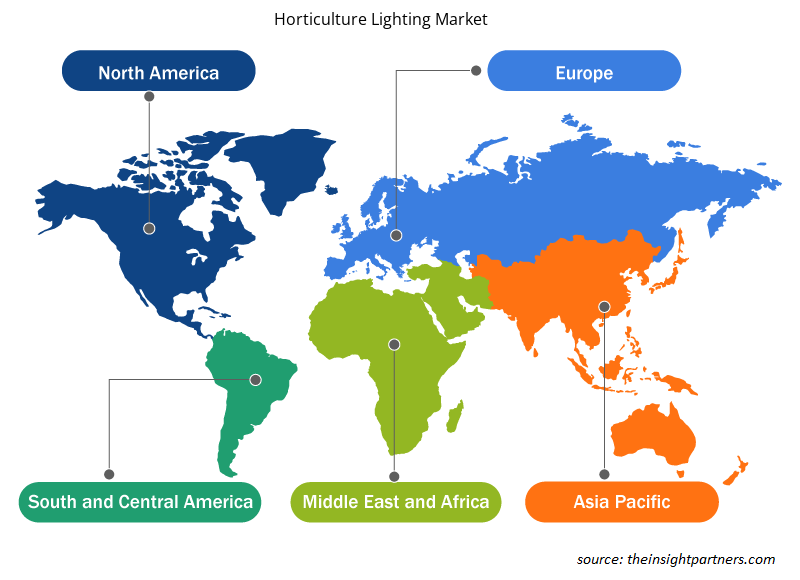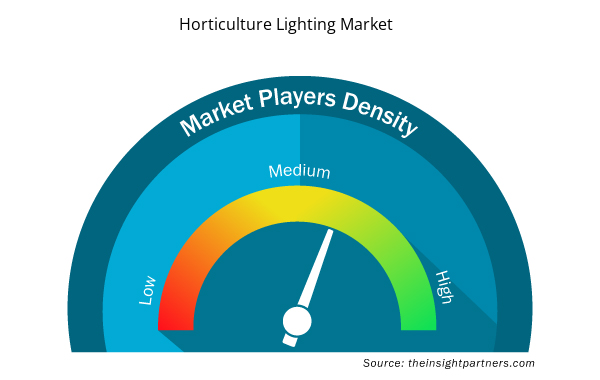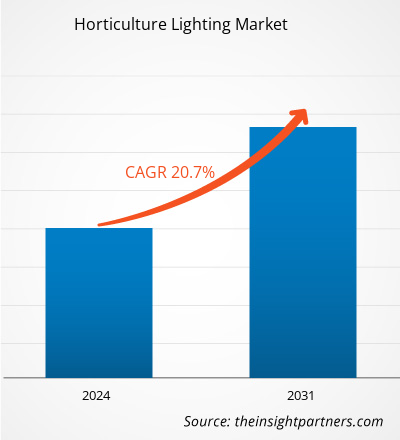The horticulture lighting market size is projected to reach US$ 24.14 billion by 2031 from US$ 5.38 billion in 2023. The market is expected to register a CAGR of 20.7% in 2023–2031. The growing demand for fresh and organic food among consumers worldwide is likely to remain a key horticulture lighting market trend.
Horticulture Lighting Market Analysis
The horticulture lighting market is growing at a rapid pace due to increasing urbanization, high food costs, environmental degradation, rising investment in modern horticulture techniques, and demand for customized lighting solutions. The market is expanding steadily, driven by the growing demand for energy-efficient farming devices and government initiatives to support indoor farming. Moreover, the rising demand for indoor farming and the expanding DIY & home gardening industry is providing lucrative opportunities for market growth.
Horticulture Lighting Market Overview
Horticulture lighting is the use of artificial light sources to help plants grow in controlled conditions such as greenhouses, indoor farms, and growth chambers. These lights play a critical role in supplying the light spectrum, duration, and intensity to simulate or augment natural sunshine, hence improving plant photosynthesis and general development.
Horticultural lighting is an important technique for increasing agricultural yields, prolonging growing seasons, and maintaining consistent plant quality. Businesses can establish optimal circumstances for diverse crops by utilizing innovative lighting technologies, such as LED systems that provide precise control over light settings, regardless of external weather or geographic constraints. Furthermore, the data-driven nature of current horticulture lighting systems enables organizations to monitor and modify lighting conditions in real-time, resulting in better-informed decision-making and resource allocation.
Customize This Report To Suit Your Requirement
You will get customization on any report - free of charge - including parts of this report, or country-level analysis, Excel Data pack, as well as avail great offers and discounts for start-ups & universities
Horticulture Lighting Market: Strategic Insights

- Get Top Key Market Trends of this report.This FREE sample will include data analysis, ranging from market trends to estimates and forecasts.
You will get customization on any report - free of charge - including parts of this report, or country-level analysis, Excel Data pack, as well as avail great offers and discounts for start-ups & universities
Horticulture Lighting Market: Strategic Insights

- Get Top Key Market Trends of this report.This FREE sample will include data analysis, ranging from market trends to estimates and forecasts.
Horticulture Lighting Market Drivers and Opportunities
Increasing Urbanization, High Food Costs, and Environmental Degradation is Driving the Market
Rising rapid urbanization increases horticultural production to meet food demand, which is likely to drive market expansion. In addition, the lack of irrigation water for farms and rising food prices shifting farmers' preference to horticulture farming is driving the market. According to the U.S. Department of Agriculture, the Consumer Price Index (CPI) rose 8.5% in July 2022. This CPI and food prices climbed by 1.1% between June 2022 and July 2022, while food prices increased by 10.9% in July 2021. Increasing consumer demand for natural and nutritious meals surges the urban horticulture product supply. The increasing usage and development of environmentally friendly and energy-efficient LEDs in horticulture to enhance crop output by reducing energy consumption drives the market during the forecast period. The DesignLights Consortium Organization estimates that horticultural lighting optimization might save up to USD 240 million in electricity each year. This encourages market players to create energy-efficient lighting for horticulture applications to fulfill rising food demand, boosting the market.
Rising Demand for Indoor Farming – An Opportunity in the Horticulture Lighting Market
The rising demand for making healthy and nutritious food at home encourages consumers to adopt indoor farming techniques, creating opportunities in the market. Indoor farming is becoming more popular in metropolitan settings as a response to food scarcity. Consumers all over the world are prioritizing the growth of the horticulture sector in order to meet food scarcity demands and encourage global horticultural exports. Increasing horticultural exports surged the demand for agriculture technology that eased indoor farming activities. The introduction of novel agriculture technology, such as LED lighting used for controlled climates in indoor farming. Thus, generating significant growth opportunities for the market growth during the forecast period.
Horticulture Lighting Market Report Segmentation Analysis
Key segments that contributed to the derivation of the horticulture lighting market analysis are technology, application, and cultivation.
- Based on technology, the horticulture lighting market is divided into fluorescent lamps, high intensity discharge lights, and LED lights. The LED lights segment held a larger market share in 2023.
- On the basis of application, the market is segmented into greenhouses, vertical farming, and indoor farming. The greenhouses segment held a larger market share in 2023.
- In terms of cultivation, the market is categorized as fruits and vegetables and floriculture. The fruits and vegetables segment held a larger market share in 2023.
Horticulture Lighting Market Share Analysis by Geography
The geographic scope of the horticulture lighting market report is mainly divided into five regions: North America, Asia Pacific, Europe, Middle East & Africa, and South America/South & Central America.
In terms of revenue, Europe accounted for the largest horticulture lighting market share, due to the presence of major lighting manufacturers such as Osram Licht AG, Valoya, Gavita, and others. These players focus on developing energy-efficient and sustainable lighting used in horticulture, which is expected to drive the market. Furthermore, countries such as Spain, the Netherlands, France, and Italy have extensive greenhouse cultivation areas. These countries employ LED lights to boost the growth of plants for indoor farming. Growing cultivation of food grains, fruits, and vegetables to supply the growing food demand in European countries increases the demand for horticulture lighting for indoor farming is propelling the market.
Horticulture Lighting Market Regional Insights
The regional trends and factors influencing the Horticulture Lighting Market throughout the forecast period have been thoroughly explained by the analysts at Insight Partners. This section also discusses Horticulture Lighting Market segments and geography across North America, Europe, Asia Pacific, Middle East and Africa, and South and Central America.

- Get the Regional Specific Data for Horticulture Lighting Market
Horticulture Lighting Market Report Scope
| Report Attribute | Details |
|---|---|
| Market size in 2023 | US$ 5.38 billion |
| Market Size by 2031 | US$ 24.14 billion |
| Global CAGR (2023 - 2031) | 20.7% |
| Historical Data | 2021-2022 |
| Forecast period | 2024-2031 |
| Segments Covered |
By Technology
|
| Regions and Countries Covered | North America
|
| Market leaders and key company profiles |
Horticulture Lighting Market Players Density: Understanding Its Impact on Business Dynamics
The Horticulture Lighting Market is growing rapidly, driven by increasing end-user demand due to factors such as evolving consumer preferences, technological advancements, and greater awareness of the product's benefits. As demand rises, businesses are expanding their offerings, innovating to meet consumer needs, and capitalizing on emerging trends, which further fuels market growth.
Market players density refers to the distribution of firms or companies operating within a particular market or industry. It indicates how many competitors (market players) are present in a given market space relative to its size or total market value.
Major Companies operating in the Horticulture Lighting Market are:
- Agrolux
- Bridgelux, Inc.
- General Electric Company
- Heliospectra AB
- Hortilux Schrader B.V
- Hubbell, Inc.
Disclaimer: The companies listed above are not ranked in any particular order.

- Get the Horticulture Lighting Market top key players overview
Horticulture Lighting Market News and Recent Developments
The horticulture lighting market is evaluated by gathering qualitative and quantitative data post primary and secondary research, which includes important corporate publications, association data, and databases. The following is a list of developments in the market for horticulture lighting and strategies:
- In June 2023, ams-OSRAM AG introduced the fifth generation of its popular OSLON Square Hyper Red horticulture LED designed to offer faster plant growth and enable optimized system cost. The company continues to provide important innovation based on customer input by creating LED solutions that produce high photosynthetic photon flux (PPF) at higher efficacy than the previous generation of Hyper Red 660 nm LEDs. The new OSLON Square Hyper Red LED is intended for use in all horticultural lighting applications, including greenhouse top lighting and inter lighting, sole source lighting, and vertical farming applications. (Source: ams-OSRAM AG, Press Release, 2023)
Horticulture Lighting Market Report Coverage and Deliverables
The “Horticulture Lighting Market Size and Forecast (2021–2031)” report provides a detailed analysis of the market covering below areas:
- Market size and forecast at global, regional, and country levels for all the key market segments covered under the scope
- Market dynamics such as drivers, restraints, and key opportunities
- Key future trends
- Detailed PEST/Porter’s Five Forces and SWOT analysis
- Global and regional market analysis covering key market trends, major players, regulations, and recent market developments
- Industry landscape and competition analysis covering market concentration, heat map analysis, prominent players, and recent developments
- Detailed company profiles
- Historical Analysis (2 Years), Base Year, Forecast (7 Years) with CAGR
- PEST and SWOT Analysis
- Market Size Value / Volume - Global, Regional, Country
- Industry and Competitive Landscape
- Excel Dataset


- Predictive Maintenance Market
- Automotive Fabric Market
- Travel Vaccines Market
- Retinal Imaging Devices Market
- Authentication and Brand Protection Market
- Saudi Arabia Drywall Panels Market
- Airport Runway FOD Detection Systems Market
- Cell Line Development Market
- Medical Enzyme Technology Market
- Embolization Devices Market

Report Coverage
Revenue forecast, Company Analysis, Industry landscape, Growth factors, and Trends

Segment Covered
Technology , Application , Cultivation and Geography

Regional Scope
North America, Europe, Asia Pacific, Middle East & Africa, South & Central America

Country Scope
Argentina, Australia, Brazil, Canada, China, France, Germany, India, Italy, Japan, Mexico, Russian Federation, Saudi Arabia, South Africa, South Korea, United Arab Emirates, United Kingdom, United States
Frequently Asked Questions
What is the estimated market size for the global horticulture lighting market in 2023?
The global horticulture lighting market was estimated to be US$ 5.38 billion in 2023 and is expected to grow at a CAGR of 20.7% during the forecast period 2023 - 2031.
What are the driving factors impacting the global horticulture lighting market?
The increasing urbanization, high food costs, environmental degradation, rising investment in modern horticulture techniques, and demand for customized lighting solutions are the major factors that propel the global horticulture lighting market.
What are the future trends of the global horticulture lighting market?
The growing demand for fresh and organic food among consumers worldwide to play a significant role in the global horticulture lighting market in the coming years.
Which are the key players holding the major market share of the global horticulture lighting market?
The key players holding majority shares in the global horticulture lighting market are Agrolux, Bridgelux, Inc., General Electric Company, Heliospectra AB, and Hortilux Schrader B.V.
What will be the market size of the global horticulture lighting market by 2031?
The global horticulture lighting market is expected to reach US$ 24.14 billion by 2031.
What is the incremental growth of the global horticulture lighting market during the forecast period?
The incremental growth expected to be recorded for the global horticulture lighting market during the forecast period is US$ 18.77 billion.

 Get Free Sample For
Get Free Sample For